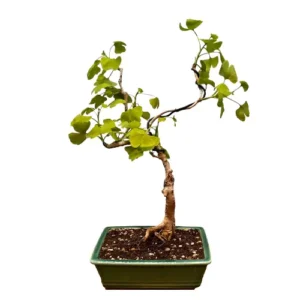ginkgo bonsai tree
Ginkgo (ginkgo biloba)
The ginkgo has unique, fan shaped leaves which turn a beautifully deep yellow colour in the autumn. It is native to China and often referred to as a living fossil, since records of its existence date back 270 million years. It is a revered tree both in nature and bonsai for its age and medicinal properties.
Placement
Choose an outdoor location that receives full sun but is protected from strong wind and scorching sunlight in the hottest part of summer days. The level of sun that your tree receives during the spring and summer will dictate how dramatic the change of colour from green to golden yellow is, in the autumn. The more light it receives, the more vibrant the yellow in autumn.
During winter, your Ginkgo will require a dormant period (approx. 3 months) which can be achieved with temperatures around 2-12 °C but it is important to protect from temperatures lower than this and especially frost. This can be done by moving you Ginkgo to a cold frame, unheated greenhouse, garage or shed. Remember to monitor weather conditions and adjust the placement of your bonsai tree accordingly to ensure its health and vitality throughout the year.
Watering
There is no definitive guide to watering and it should be conducted on an observational schedule, not a routine. This means that it is important to keep an eye on the moisture levels of the soil to avoid over and under watering, both which can lead to dropping leaves and/or root death. The amount of water a bonsai requires depends on pot size, climate, airflow, soil and tree type so it is best to use your eyes and fingers to assess whether the soil is damp, wet or dry.
If the top inch or so of soil has dried, it is ready to be watered. When you water, ensure an even coverage over the roots and soil, allowing water to flow out from the bottom of the pot to ensure a good soaking. If you are a first-time bonsai owner, another good way to water is by submerging the entire pot in water until the bubbles stop. If you choose this method, be aware that your bonsai may not need watering for another two or three days, but this will depend on the factors mentioned above.
Fertiliser
Using fertiliser on your Ginkgo bonsai tree will help encourage healthy growth and this should be done periodically from once a week to every two months and only during the growing season. You can start adding Chrystal Liquid Bonsai Feed to your water from March until October and use weekly. Use Naruko Fertiliser Slow Release Bonsai Feed once every one to two months. With bonsai trees, less is more, and we tend to advise using half the recommended dosage to see how your ginkgo bonsai tree reacts first.
Pruning and wiring
Pruning your bonsai is important not only to maintain or create an aesthetic style but to also ensure light and airflow can reach inner leaves. Constant trimming of new shoots will help to thicken the trunk of the Ginkgo bonsai tree. During the early to late spring months use appropriate tools to cut back stems which have grown longer than four leaves, leaving the two leaves which are closest to the stem intact. Keep in mind that unfortunately the Ginkgo bonsai tree does not heal well or quickly from wounds and any incisions will leave visible scars. Pruning therefore should be thought about very carefully, wound paste should be used and producing large wounds should be avoided.
The Ginkgo can be trained using wires all year round and the branches are quite flexible. The bark however is very delicate and it is recommended to wire with care and check that the wires do not bite in which will leave scarring. Ginkgo bonsai tree are usually styled into the flame shape.
Repotting
Repotting your tree is an important way to provide a fresh and suitable soil mix and ensure appropriate root health. Repot in early spring. Generally, your Ginkgo will need to be re-potted once every year if it is young, while older ones can stay in their pots for longer. However, you should always check if it has become root-bound before you change pots. You can do this by lifting the tree gently out of the pot by the main trunk and examining the root system. You will know it is ready if you can see that the roots are circling around each other and the pot. If, however, they still appear contained in the soil, you should place it back and wait until the following spring to check again.
Choose a pot that is slightly bigger, reflects the tree’s style, leaf and bark colour and is a suitable material.
The roots do not need to be pruned too heavily as they will not tolerate a large root reduction well and the Ginkgo can be potted in a wide range of soils, as long as it is well- draining. We tend to use a mixture of different speciality bonsai soils on our trees. Every species is different so please contact us for free soil-mix advice or to take advantage of our re-potting service, visit www.miyagibonsai.co.uk/services/.
For further information and advice on your bonsai tree, please refer to our blog at ………..
For tools, fertilisers, soils, pots and other accessories please visit…….
Showing all 2 results


